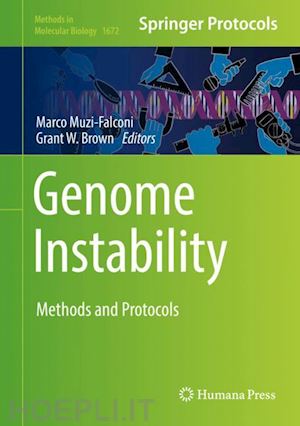
Questo prodotto usufruisce delle SPEDIZIONI GRATIS
selezionando l'opzione Corriere Veloce in fase di ordine.
Pagabile anche con Carta della cultura giovani e del merito, 18App Bonus Cultura e Carta del Docente
This volume presents forty-two methods and protocols to analyze diverse aspects of genome instability. Chapters detail mutagenesis and repair, methods to quantify and analyze the properties of DNA double-strand breaks, profile replication, replication proteins strand-specifically, genome instability, fluorescence microscopic techniques, and genomic and proteomic approaches. Written in the highly successful Methods in Molecular Biology series format, chapters include introductions to their respective topics, lists of the necessary materials and reagents, step-by-step, readily reproducible laboratory protocols, and tips on troubleshooting and avoiding known pitfalls.
Authoritative and cutting-edge, Genome Instability: Methods and Protocols aims to provide a comprehensive resource for the discovery and analysis of the proteins and pathways that are critical for stable maintenance of the genome.
The A-like Faker Assay for Measuring Yeast Chromosome III Stability.- The Chromosome Transmission Fidelity Assay for Measuring Chromosome Loss in Yeast.- Measuring Mutation Rates using the Luria-Delbrück Fluctuation Assay.- Molecular Genetic Characterization of Mutagenesis Using a Highly Sensitized Single-Stranded DNA Reporter System in Budding Yeast.- Analyzing Genome Rearrangements in Saccharomyces cerevisiaen: initial; background-size: initial; background-repeat: initial; background-attachment: initial; background-origin: initial; background-clip: initial;">.- High Resolution Mapping of Modified DNA Nucleobases using Excision Repair Enzymes.- Integrated Microarray-based Tools for Detection of Genomic DNA Damage and Repair Mechanisms.- Study of UV-induced DNA Repair Factor Recruitment: Kinetics and Dynamics.- Inserting Site-specific DNA Lesions into Whole Genomes.- A qPCR-based Protocol to Quantify DSB Resection.- Alkaline Denaturing Southern Blot Analysis to Monitor Double-strand Break Processing.- Single Molecule Analysis of Resection Tracks.- Mapping DNA Breaks by Next-generation Sequencing.- Genome-wide Profiling of DNA Double-strand Breaks by the BLESS and BLISS Methods.- DNA Replication Profiling using Deep Sequencing.- Quantitative Bromodeoxyuridine Immunoprecipitation Analyzed by High-Throughput Sequencing (qBrdU-seq or QBU).- Strand-specific Analysis of DNA Synthesis and ProteinsAssociation with DNA Replication Forks in Budding Yeast.- Analysis of Replicative Polymerase Usage by Ribonucleotide Incorporation.- Dynamic Architecture of Eukaryotic DNA Replication Forks in vivo, Visualized by Electron Microscopy.- A Molecular Toolbox to Engineer Site-Specific DNA Replication Perturbation.- Single Cell Gel Electrophoresis for the Detection of Genomic Ribonucleotides.- Measuring the Levels of Ribonucleotides Embedded in Genomic DNA.- Mapping Ribonucleotides Incorporated into DNA by Hydrolytic End-Sequencing.- Detection of DNA-RNA Hybrids in vivo.- Analysis of de novo Telomere Addition by Southern Blot.- Assays to Study Repair of Inducible DNA Double Strand Breaks at Telomeres.- Telomerase RNA Imaging in Budding Yeast and Human Cells by Fluorescent in situ Hybridization.- Methods to Study Repeat Fragility and Instability in Saccharomyces cerevisiae.- Quantitative Analysis of the Rates for Repeat-mediated Genome Instability in a Yeast Experimental System.- Measuring Dynamic Behaviour of Trinucleotide Repeat Tracts in vivo in Saccharomyces cerevisiae.- The Detection and Analysis of Chromosome Fragile Sites.- Imaging of DNA Ultrafine Bridges in Budding Yeast.- Detection of Ultra-Fine Anaphase Bridges.- A Chromatin Fiber Analysis Pipeline to Model DNA Synthesis and Structures in Fission Yeast.- Long-term Imaging of DNA Damage and Cell Cycle Progression in Budding Yeast Using Spinning Disk Confocal Microscopy.- The CellClamper: A Convenient Microuidic Device for Time-Lapse Imaging of Yeast.- Characterization of Structural and Configurational Properties of DNA by Atomic Force Microscopy.- Genome-wide Quantitative Fitness Analysis (QFA) of Yeast Cultures.- Rewiring the Budding Yeast Proteome using Synthetic Physical Interactions.- Reporter-based Synthetic Genetic Array Analysis: a Functional Genomics Approach for Investigating Transcript or Protein Abundance Using Fluorescent Proteins in Saccharomyces cerevisiae.- Statistical Analysis and Quality Assessment of ChIP-seq Data with DROMPA.- Quantitative Analysis of DNA Damage Signaling Responses to Chemical and Genetic Perturbations.











Il sito utilizza cookie ed altri strumenti di tracciamento che raccolgono informazioni dal dispositivo dell’utente. Oltre ai cookie tecnici ed analitici aggregati, strettamente necessari per il funzionamento di questo sito web, previo consenso dell’utente possono essere installati cookie di profilazione e marketing e cookie dei social media. Cliccando su “Accetto tutti i cookie” saranno attivate tutte le categorie di cookie. Per accettare solo deterninate categorie di cookie, cliccare invece su “Impostazioni cookie”. Chiudendo il banner o continuando a navigare saranno installati solo cookie tecnici. Per maggiori dettagli, consultare la Cookie Policy.